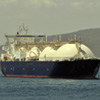FLNG
Acronym for “floating liquefied natural gas.” An FLNG facility would float offshore and be used for natural gas liquefaction and regasification.
- A shift from land-based natural gas liquefaction plants to ocean-based plants
- Accelerated practical application of the FLNG concept thanks to technological innovations
- Prospect of becoming a main energy supply source

A shift from land-based natural gas liquefaction plants to ocean-based plants
FLNG stands for “floating liquefied natural gas.” An FLNG facility would float offshore and liquefy or regasify natural gas. Another term that is used is LNGFPSO (floating production, storage and offloading system for LNG).
Conventionally, ocean floor natural gas is supplied through pipelines from fixed natural gas extraction platforms built on the ocean floor to refining and liquefaction facilities on the land for the processing of extracted natural gas into LNG (liquefied natural gas). LNG is then loaded onto LNG carriers for transportation to gas terminals in consuming nations for regasification to produce the final product to be delivered to consumers.
This process, however, is inefficient and time-consuming because it involves the transport of natural gas obtained from the ocean floor up onto land facilities for processing, and then back to the ocean (to LNG carriers) for delivery to customers. Furthermore, it lacks flexibility, since it is necessary to find a suitable site for constructing a refining/liquefaction plant close to the extraction platforms. The FLNG concept aims to streamline the entire production process by consolidating the series of steps beginning with natural gas extraction and continuing to liquefaction, storage on a floating facility, and loading of the finished product onto LNG carriers.
Accelerated practical application of the FLNG concept thanks to technological innovations
For petroleum production, the concept of a floating facility, which also underlies the basic idea of FLNG, was put into practice in the 1990s. In the case of FLNG, however, until several years ago there were a number of technological obstacles in the refining, liquefaction, storage, and delivery processes that prevented practical application.
Recent technological innovations have begun to overcome those obstacles. In fact, Australia has initiated a full-fledged FLNG project with plans to begin production with a processing capacity of 3.6 million tons per year in 2017. Around the world, in countries such as Brazil and Malaysia, other projects are also moving forward.
Prospect of becoming a main energy supply source
Although natural gas holds the prospect of becoming a main energy resource in the future, full-scale landbased extraction of natural gas from underground is possible only in certain areas such as North America and Russia. It is said that most of the natural gas reserves lie under the Middle East, the Atlantic Ocean, and the Pacific Ocean. The FLNG is expected to become one of the main types of energy plant in the future.


